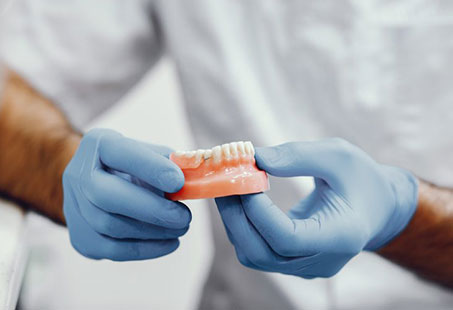All-on-4 dental implants refer to the placement of prosthetic devices like dentures on just four dental implants fitted into the jawbone. This technique was specifically developed for patients with already or soon-to-be missing teeth.
But besides helping restore the function and aesthetics of the mouth, this procedure can also help patients save costs. That’s because the way it is done, the patient might not need additional procedures like bone grafting before the placement of implants.
Of course, it doesn’t guarantee to entirely eliminate the need for a graft, but all-on-4 dental implants can make it possible. Even so, there are certain limitations of these implants, and they’re not completely without risks, either.
What Is An All-On-4 Dental Implant?
Developed by Paulo Malo, all on 4 dental implants are the placement of two posterior implants titled up to an angle of 45 degrees, along with two anterior implants placed vertically.
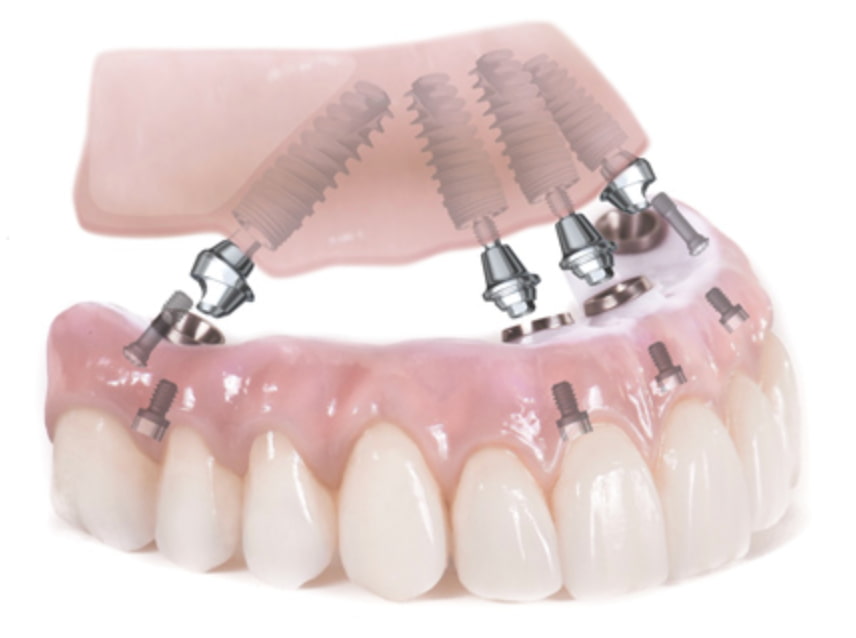
Normally, restoring a full arch of missing teeth requires the use of 5-10 dental implants, according to a study published in the Journal of Dentistry of Tehran University of Medical Sciences. However, with this mechanism, it’s possible to do that with just 4 implants (per arch/jaw).
There are several advantages to this technique, such as getting good anchorage for the implant in the jawbone and providing adequate support for the restorations on top. But it has another notable feature, namely “immediate loading.”
It means that the implants can be immediately loaded with a prosthesis without any delay (usually within 48 hours). This is unlike what usually happens, as in order to reduce the risk of implant failure, it’s kept “load-free” for 3-6 months (temporary prostheses are given instead).
During this time, the implant undergoes a process known as “osseointegration,” in which it literally integrates with the jawbone. Still, while it may be possible, immediate loading isn’t always done.
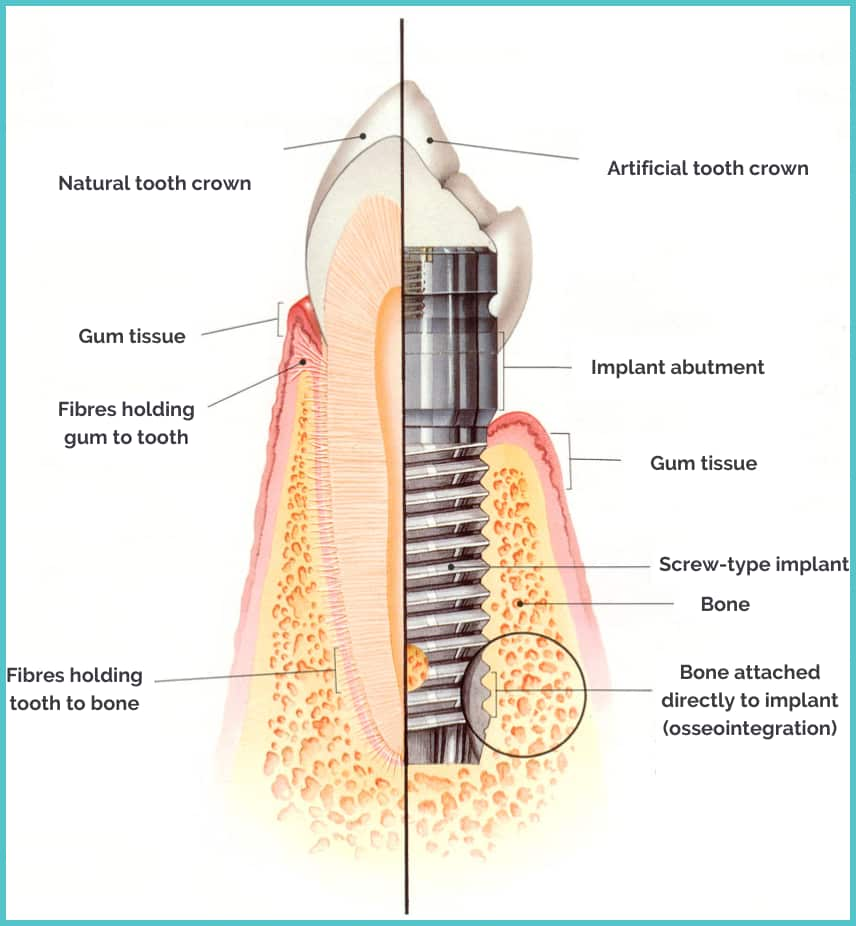
Another benefit of all-on-4 dental implants is that it does away with the use of removable dentures. This feature is not unique to this implant placement technique, but with it, you can get your dentures permanently fixed into your mouth.
Unlike removable dentures, you don’t have to worry about them slipping out of place, and you’ll be able to talk and eat more easily. Fixed prostheses can be more comfortable to wear, and they can also look and function like your natural teeth.
How Much Do All-On-4 Dental Implants Cost In The UK?
In the UK, all-on-4 dental implants per jaw may cost you around £15,000 or more, inclusive of:
- Implants
- Abutments
- Temporary and permanent prostheses
So, if you’re seeking a full-mouth restoration for both the upper and lower jaws, you can expect it to cost about £30,000. And some patients might also need more than 4 implants per jaw for their rehabilitation, so that will also add to the total.
Additionally, keep in mind that prices can vary depending on the materials used, location of the clinic and the experience and qualifications of your dentist.
If you need additional surgeries like bone ridge reduction, bone grafting, or gum contouring, the overall expense of this procedure can be prohibitive.
Because of this, some clinics offer different financing options so that you make the payment over a few months or a year. However, it can be still quite expensive.
How Much Are All-On-4 Dental Implants In Turkey?
On average, the all on 4 dental implants in Turkey price can be around £4,000 per jaw, including the prosthesis.
Because of the low cost of living and the Turkish economy, dental services are more affordable for foreigners.
However, the all on 4 dental implants in Turkey prices can vary depending on the material from which the arch is made.
Make sure to check the all on 4 dental implants in Turkey reviews and before and after photos of the dentist to assess their work.
Which Is The Cheapest Country For All-On-4 Dental Implants?
Some of the cheapest places to get all-on-4 dental implants are as follows:
| Country | All-On-4 Price/Jaw |
| Mexico | £5,500-£10,000 |
| India | £4,000-£6,500 |
| Hungary | £7,000-£10,000 |
| Poland | £7,000-£13,000 |
| Thailand | £7,000-£10,000 |
| Turkey | £4,000-£5,000 |
However, don’t just go for the cheapest country for all on 4 dental implants. You must do your research to make sure that the dentist is qualified and they’re using safe materials for your procedure.
What Are the Different Types of All-On-4 Dental Implants?
There are two main types of all-on-4 implants, both of which contain a titanium screw. However, it is the denture that is either made of:
- Acrylic – It is a type of plastic that is used in many dental restorations. While the front of the dentures has a natural appearance, with the gummy pick plastic on top, this type of denture also comes with a titanium base on top that supports the implants. This option is the cheapest, but it may not look the most natural.
- Porcelain – Because of the different properties of the material, for instance, the way that it reflects light, porcelain looks like natural teeth. It is also stronger than acrylic but also more expensive.
How To Clean All-On-4 Dental Implants?
If you have all-on-4 dental implants, your dentist may recommend using a super floss or x-floss to keep them clean. There are soft and thick subsections on these flosses that are then used to clean spaces between implants.
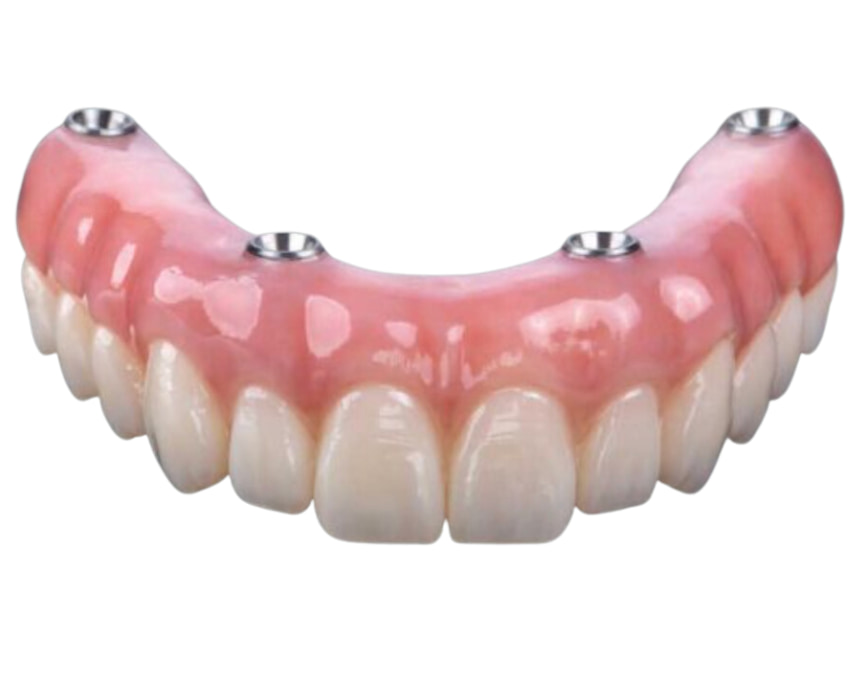
You can use them as follows:
- Take the firm end of the floss and insert it in the gap between your denture and real gums until it comes out the other side.
- Slide the spongy section of the floss back and forth between the two implants.
- Take the floss out and re-insert to clean all the other gaps (in the upper and/or lower jaw), including the back.
It can take some time to get used to, however, it’s important to keep the underside of the denture clean. And other than that, your dentist might also recommend using a waterpik (with sometimes an antibacterial mouthwash mixed with water, but you must consult your dentist about this first).
You might have to floss twice a day for your lifetime, but the frequency is something that you should further discuss with your dentist. Besides flossing, you’ll also have to brush the surfaces of your dentures gently.
What Is The Procedure For All-0n-4 Dental Implants?
There are some variations in the way that this procedure is performed by different dentists. Regardless, the first step is the physical examination of the mouth and an X-ray.
If you still have a few teeth remaining, it is possible that the surgeon begins by extracting all of them. If that happens, you’d have to wait for 2-3 months before getting the all-on-4 dental implants. That’s because the tissue needs to heal. However, it is followed by this:
- Once you come in to get your implants, the surgeon will take a few measurements and check the distance between the upper and lower jaw.
- They will assess the bone ridge. In some cases, dentists make a cut through the whole ridge and pull apart the flaps to reduce the underlying bone. This is done to improve the final outcome of the procedure.
- This alveolar reduction is not always needed. In that case, the dental surgeon will make small incisions into the gums and drill holes into the bone for the placement of the titanium screw of the implants.
- To adequately support the prosthesis, the posterior two implants are placed at an angle of 45 degrees, and the anterior ones are at a 90-degree angle.
- After the placement of the implant, the abutment is placed on top. The temporary prosthesis is then drilled with holes at the points where it touches the abutments. It is then fitted into the mouth to see if it fits well.
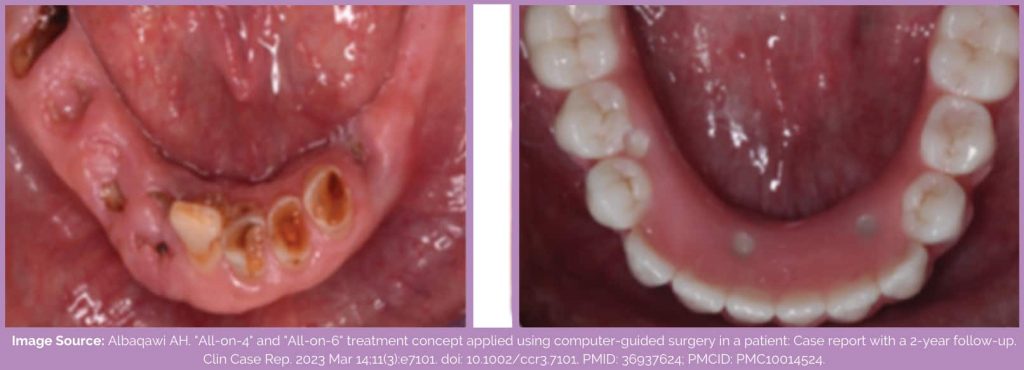
If everything’s good, the holes are filled, and the patient has to wait a few months for the osseointegration process to take place. This is when the bone fuses with the titanium screw.
You’ll have to come in for a second appointment, where the impression of your teeth will be taken, and a final prosthesis will be fitted afterwards.
How Long Does It Take To Get All-On-4 Dental Implants?
An all-on-4 dental implant treatment can usually take 3-6 months. It’s because after the implants have been fitted, they take some time to fuse with the jawbone.
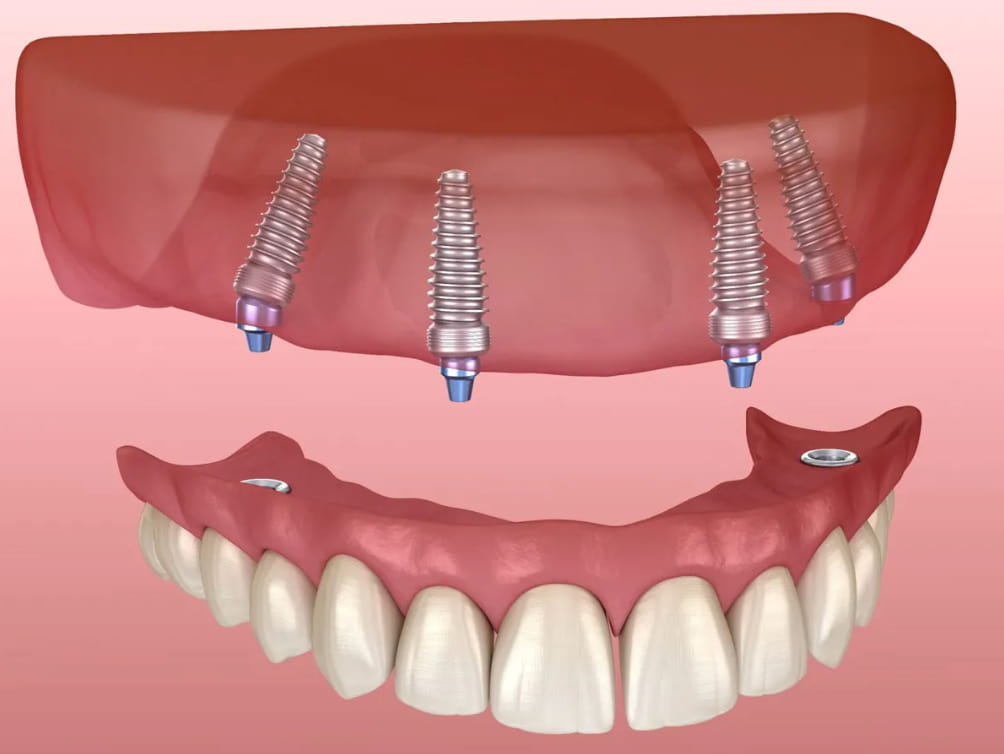
During this time, patients are typically fitted with temporary dentures. After the healing, however, the permanent prosthesis is placed.
But this isn’t how it always happens. Some dentists also offer to fit the permanent teeth the next day after the implant surgery. In any case, make sure to discuss the pros and cons of each method with your dentist.
Do All-On-4 Implants Hurt?
All-on-4 dental implant surgery takes place under local anaesthesia so you shouldn’t feel pain during the procedure.
However, once the effects of the anaesthesia wear off, you’re likely to have pain, swelling and soreness. Your doctor might prescribe painkillers to you to relieve the pain.
If you’d like to get sedation for the procedure, you should discuss it with your dentist beforehand.
What To Expect After All-On-Four Surgery?
While some patients can get back to their normal routine even a day after the surgery, it is recommended that you rest for 3-4 days. That’s because you may experience:
- Swelling
- Tenderness
- Bruising
- Pain
- Slight bleeding
You might also have stitches in your mouth. Whether or not they’re dissolvable, they’ll be in your mouth for a few weeks, so you have to be very careful.
Your dentist might recommend only eating soft foods for a few days and avoiding drinking or smoking to allow the surgical wound to heal. In addition to painkillers, you might also have to take antibiotics to manage the side effects.
However, with time, you should start to get better. If that’s not the case, you should immediately get in touch with your dentist.
Do All-On-4 Dental Implants Feel Natural?
While all-on-4 dental implants can look and even function like natural teeth, they won’t necessarily feel like natural teeth.
The implant screws will take some time to get used to along with the prosthetics. The latter is made from artificial material, so you can expect it to feel different. However, you’ll get used to the feeling.
Are All-On-4 Dental Implants Permanent?
All-on-4 can be permanent and they can last a lifetime. According to an 18-year follow-up study on all-on-4 treatment published in the Clinical Implant Dentistry and Related Research, these implants had cumulative survival and success rates of 93% and 91.7%, respectively.
The researchers also found the cumulative survival rate of the prosthetic device to be around 98%. So, this treatment can give you lasting results, although there can be differences depending on the material used. For instance, zirconia implants might not last as long as titanium implants.
Another important thing that can affect the longevity of your all-on-4 implants is your oral hygiene. You need to make sure that the dentures and the gums underneath are clean to avoid problems like infections.
Are All-On-4 Implants Worth It?
Compared to removable dentures, implants are certainly more durable. You can easily bite down on hard, chewy foods with them. And they’re permanent.
An added benefit of this procedure is that because of the angling of 4 implants, a full set of teeth can be supported.
Sometimes, it also makes it possible to perform the surgery without a need for bone grafting. A smaller number of implants make the procedure less costly and recovery less difficult.
Is All-On-4 Implants Failure Possible?
There’s a very small risk of all-on-4 implant failure. This happens when the titanium screw doesn’t integrate with the jawbone. This could be because you didn’t receive a needed bone graft. It can also occur due to an infection or problems with the procedure, such as the improper placement of implants.

A rare allergic reaction to the titanium screw is also possible. Other than that, an underlying health condition or damage to nerves can also cause this problem. However, it is possible for you to get another implant if something like this happens.
Some other all on 4 dental implant problems include:
- Breakage of the prosthetic device
- Fracture of the implant screw
- Loose prosthetic and/or abutment
- Opening of the wound
- Implant loss
If you’re having difficulty talking and eating food, notice a discharge, are not feeling well, or think something’s wrong with your implants, make sure to get in touch with your dentist as soon as possible.
Are All-On-4 Dental Implants Safe?
All-on-4 implant procedure is considered safe. However, of course, like any surgical procedure, it can carry certain risks, such as loss of implant, implant failure, infection, bleeding, nerve damage, etc. You should discuss these with your dentist beforehand.
Conclusion
All-on-4 implants are being used to restore the function and aesthetics of the mouth. It has the unique advantage of restoring teeth in one arch by supporting the entire denture on 4 implants only.
This is possible because of the angles in which they’re placed. However, in some cases, patients may require 5 or 6 implants. Since this procedure can be quite expensive, many patients choose to travel to Turkey because of its more affordable dental care.
Here, you should also keep in mind that you may need additional surgeries along with dental implants like bone grafting or ridge reduction. These may be needed to better support the implant and the denture that goes over it. The results of this treatment are permanent.
However, very rarely do patients experience dental implant failure. Even in that case, it is possible to get another set of implants. In any case, you should make sure to consult a dentist about it.
